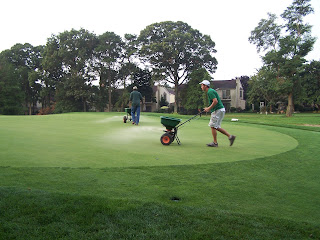Within the next two weeks, we will enlarge our staff with
four..........
.........goats!
Last spring (2011) I suggested using goats to manage poison
ivy and brush in the wooded and natural areas throughout the course. I thought that
goats would be a better alternative than drenching these areas with herbicides
that in turn could hurt the trees and other desirable plants, and maybe the
birds and other wildlife that have come to live in these areas. At first the
suggestion was taken lightly by the club, but in time, it began to make sense,
and late last fall I was given the ok to give it a try!
Goats are not new to me. I have a small “farm”, and years
ago I adopted a dwarf Nubian goat. One goat doesn’t make a herd, nor does it
make me an expert, but from “Snoops” I learned a lot about goats – their
personalities, management, diet, uses, etc. Over the years, goats have become
one of my favorite animals, even surpassing dogs. Fact is, some goats are smarter than dogs, and
at some things, are more useful. Goats don’t chase geese so much, but they have
other positives, such as the ability to browse, and an independent attitude. They
are also affectionate and form very tight and life lasting bonds with people
and other animals such as horses.
The term “got your goat!” comes from the race track. Years
ago, a goat would be stalled with a nervous race horse as a companion to keep
it calm and to give it a bit of playful company and in time the bond between
the horse and goat would become very strong. Sometimes a competing horse owner
would have the goat stolen right before race day, upsetting the horse enough so
that it wouldn’t race well....hence, “got your goat!”
There are many types and breeds of goats for all kinds of
uses. There are breeds for milking, showing, hair (for “wool”), meat, cart
pulling, and security! Some goats are used as pack animals since they are
sturdy and sure footed.
I chose to use Boer goats for this project – Boers are a
meat goat breed that originated in South Africa, and the breed is known
to be very hardy in all types of climates and environments. Last fall I put a
reserve on three kid does (female babies) from “Just Kiddin Around” farm,
located near Allentown PA. Kidding season was late this spring, and
I wasn’t able to pick up the goats till the first week of June. Although I had
reserved three, I ended up taking four, all 3 months old. That’s four lucky little
goats – Irene, Francis, Mary, and Lucy - that otherwise would have been fattened
up shipped off to be dinner.
Since they have been on my farm, I have spent time getting
them used to people and to being handled. I have also been slowly taking them
off grain and onto hay and browse. At the farm they are fed sugary grain to
fatten them up and to get them to market quicker - so in a funny twist, they needed
to be introduced to their natural diets.
Hard for some to believe, but goats don’t eat everything....
Goats don’t eat tin cans or tires or cars. They are not the best grass eaters
either, but prefer to browse on leaves of most deciduous plants. This includes
brush, ivy, and trees. Many plants though, such as yews, laurel, and azaleas
are poisonous to goats. Goats are not indestructible as some people might
think. Still, their ability to consume poison ivy, wild rose, green briar, etc
makes them seem so.
My plan is to put the goats in the naturalized area between
holes 8-9-10 and let them get used to things around here. I will start with
two, then in a week or so, bring in all four. We will eventually move them to
the wooded and overgrown brush areas along holes 7 and 8. We will use
temporary, moveable fencing to keep them in the area we want cleared. They won’t
be staying overnight – too many problems with pranks and predators could occur
- I will be taking them back and forth each day.
The best thing to do with the goats is to just watch them,
enjoy them, and let them be – please do not feed them any treats. If your ball
lands in their fenced in area, please take a drop. Please do not go into the
fenced area. Although the goats won’t harm you, its best not to pester them.
I am really excited about doing this! Goats are a great
alternative to herbicides, fit nicely with our Audubon program, and will be a
lot of fun while we reclaim areas of the course!















































